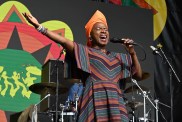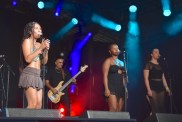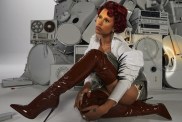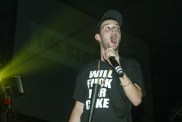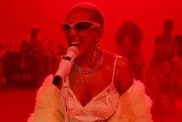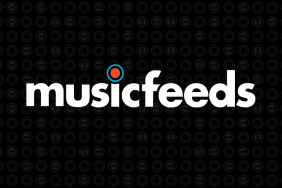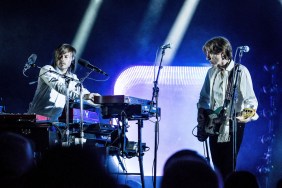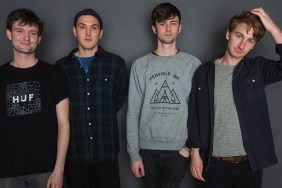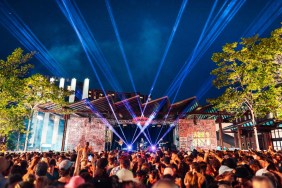Jono Ma of Jagwar Ma grew up in the golden age of VHS. A time where a five-for-five-dollar rental deal was a one-way ticket to a blissful week of Space Jam, Terminator and Stand by Me watched as many times you cared to hit rewind.
Looking to capture the magic of this nostalgic era in film Ma, alongside long-time collaborators Jonti Danilewitz (Stones Throw Records) and Pat Santamaria (BABEKÜHL), is hosting a one-off Vivid Sydney performance. Titled Teenage Wasteland, the cinematic event promises to be an immersive mix of cult movie soundtracks, mesmeric light shows and vintage synthesisers. It is a night not to be missed if the enthusiastic trio are to be believed.
Music Feeds: How did Teenage Wasteland come about? Is there a connection between all three of you people may not know?
Jono Ma: Wow, where do we begin? There are so many cross-connections. Pat and I played in a band together called The Valentinos that later changed its name to Lost Valentinos. That is where I met Pat. Kirin J Callinan was in the band and Daniel Stricker from Midnight Juggernauts.
I replaced Kirin on guitar. Pat was on bass. (Pat was one of the founding members.) On the side, I was producing another band called Sherlock’s Daughter which Jonti was playing keyboards in. Which is how I met Jonti.
Jonti actually played keys on one of the songs on the first Valentinos album. I was like, “Can you put some moog on this track!?” So I guess that was the first time we were all on the same recording together.
Pat: This is back to 2007 or something! Almost 15 years ago. We all kind of walked our own paths in that 15-year interim. And then intersected again in recent times. And now we are entering a new time of collaborative fruitfulness
Jono: Since that moment where we all first met and worked, Jonti went on to release records at Stones Throw. Pat simultaneously went into making music and starting the record label, the warehouse events program, the cultural revolution that is Motorik. And I went on to do Jagwar Ma.
With Jagwar Ma, Pat and I kept collaborating visually. Pat did a lot of the artwork for Jag, and when we were touring Jonti came with us as well. So, over the past 15 years, we have been working together, collaborating for a long time.
Jonti and I also started a side project called MYSTICS. Did we play one of the Vivid Sydney sideshows Jonti? At Frida’s?
Jonti: Yep.
Jono: Then we went on to do a show at Splendour In The Grass. Pat also worked on the visuals for that and the artwork for MYSTICS. But then this specific project, this format with Pat doing live visuals and Jonti and I working on the music?
This idea for Teenage Wasteland was seeded from a project we did in Byron Bay. It was when dancing was still outlawed. There is a theatre in Byron Bay where there was a guy doing curated film nights with an extracurricular offering to the film itself.
He had, for example, Mad Max and some of the cast of Mad Max doing Q & As before the film. He approached me while I was running a club in Byron Bay and asked me to DJ before the Goonies. He asked me to do an ‘80s pop DJ set.
And I was like, “I don’t know if I’m your guy for that but what other films have you got coming up?” He sent me a list of some other films that he could get the rights to and screen with this type of entertainment offering capped on to the side. I saw Blade Runner on the list and immediately I thought we could create a really amazing world and do something around Blade Runner.
That is when I brought Pat and Jonti into the equation. We came up with this audio-visual show based around the world of Blade Runner. We reinterpreted different moods and scenes from the film in our own way and had a lot of analogue synths. Kind of like what Vangelis would have used.
This show in Byron, inspired by the world of Blade Runner was the first time. After we were like, “A) This is really fun, B) like really rewarding, and C) everybody really enjoys it!” So we were like, “We really want to keep doing this!” It was almost like forming a band. So this is the new “band” we do AV stuff based around film inspirations.
Music Feeds: What era of films is Teenage Wasteland concerned with?
Jonti: ’70s,’80s, and ‘90s.
Pat: Part of the aesthetic is ‘70s,’80s, and ‘90s. But really the way we are thinking about it is The VHS Era. Going to a video store and having very little concept of these giant libraries of films, you would be hiring a handful of weekly Five-for-Five-Dollar deals, going home and just watching random stuff!
A lot of those times these tapes would be old, worn down, warping, glitched out and degraded in an analogue way. That’s all part of the aesthetic as well. So it’s not necessarily about the films just being from a certain era but being something that is from that VHS mindset.
Music Feeds: What kind of movies were you taking home? What inspired you?
Jonti: It changed so much if I’m being completely truthful. What inspired me was probably stuff like Space Jam! But growing older and understanding a lot more about electronic music and composing, I think it has changed.
Now it’s John Carpenter! I’ve been listening to all the soundtracks, especially recently, I think Escape From New York is incredible and inspiring. I think my personal favourite soundtrack of all time is The Warriors soundtrack. It’s a good mixture of live bands and synths doing weird sh*t and stuff. That’s my vote!
Jono: When I was in the video shop phase I think, like Pat mentioned, you had very little context with what you were choosing. There are a few things that would always jump out like the film title. Also, we used to have slumber parties. You would all go into the video shop as a group of kids. You would just get drawn in!
There was one particular friend in the group of friends I had growing up whose parents would allow us to watch R-rated films. So we would always have slumber parties at his place. His parents would let us go to the horror section and the science fiction section and pick out Total Recall, Terminator and all the Arnold Schwarzenegger films.
Aliens too. All the things our parents were not allowed to know we were watching. Anything with Schwarzenegger in it was definitely a bargain in the weekly bin. I remember watching Terminator 2 and being not only blown away by the film and the storyline itself but also the soundtrack, the theme and the music supervision on it! I didn’t even know what that was at the time but the way it all pulled together sonically was mind-blowing.
Terminator 2 is probably more of a hi-fi blockbuster example of what we are inspired by at the moment. In the horror section, it was loads of John Carpenter stuff and anything written by Stephen King. John Carpenter is such a great example of somebody who would really create his own world. Not just with his direction and screenplays but also the music and the sound design. That is really what I think Teenage Wasteland was about for us. It is an exercise in world-building. We were really inspired by the idea of using sound and vision to create a whole new environment you can escape to.
Pat: Often a soundtrack or the visual elements of a film, by themselves, would be nothing without each other. That aspect of the two coming together is what Teenage Wasteland is about. Worldbuilding. And referencing that auteur experience. A lot of time in the ‘70s and ‘80s films were super lo-fi and super low budget. John Carpenter is an excellent example of someone doing everything himself – writing, directing, editing, and doing the soundtrack. That contributes to a film being a really concise, realized vision of a world. Which I think the three of us can maybe get done (as well as the show).
View this post on Instagram
Music Feeds: What have you learned as a result of working on Teenage Wasteland?
Pat: I’ve learned from this experience that a powerful piece of music allows you to really dive into simplicity visually. One of the most powerful things that we have been working on has been a super simple visual loop. Very simple. But when paired with the right audio, the right music can really take on its own meaning. Finding the power in the simplicity has been my big takeaway from doing this project.
Jonti: It has been the same for me. The simplicity from listening to John Carpenter soundtracks – when you listen to it on its own it might be a steady one-note. Not that interesting on its own merit. But with the context within the movies? It’s perfect!
The music is amplified with the image. It becomes so powerful. As a result, I have a new appreciation of simplicity, space and how that works in the audio-visual realm.
Jono: For me, I think something more technical opened up when we started working on this project. Previously whenever I’ve been working on music projects it has always been with stereo composition, two tracks and two speakers. The eye-opening thing when we did Blade Runner and Teenage Wasteland is opening up to the surround sound space. It is something you only really experience in cinemas and some AV venues.
Blade Runner was the first time I have ever mixed with more than two outputs. We were able to start sending elements of the music to rear speakers and that made me really appreciate the cinema, that idea of a 5.1 or a 7.2 surround sound mix. I am now really appreciating the detail that goes into the balance between sound design, music, narrative, and dialogue. All those things!
Music Feeds: What can people expect to see from you at Vivid Sydney?
Jono: We have a shared list of so many films we have been watching broken up into different categories. One of the running themes for Teenage Wasteland is anything with a dystopian undercurrent. We have been watching a lot of sci-fi classics, almost every John Carpenter film ever made – which is a lot! That covers a lot of ground, obviously Blade Runner and all the Ridley Scott films, the Alien world franchise, James Cameron…
Jonti: Total Recall!
Jono: All the Schwarzenegger classics, Terminator. RoboCop too. But we have also been interested in some of the Coming-of-Age films of this period as well. So it’s not just, all real blokey, gory action sh*t. We have been really appreciating things like American Graffiti and Stand By Me – there are these more sentimental sorts of musical worlds in those films. I feel like there is a whole world of films escaping my memory.
Pat: We were not really pressing on one genre or director. Film lovers will be able to come and train-spot essentially! There will be lots of clues in there. But then also, if you have no background in film or that’s not your vibe, you are going to be experiencing the emotion of those films created. It is going to work on different levels.
Music Feeds: What can you tell me about the visual component of Teenage Wasteland?
Pat: The two aspects of the show have been developed hand in hand. Obviously, there is going to be a big screen projected onto the wall but there is also going to be a big lighting installation. We are going to use the space to create dimension with sound. There is also going to be a lighting installation that comes out, into the audience giving it an immersive feeling.
This is also drawing on our background in electronic music, which is all about creating transformative spaces. That whole genre is a discussion in itself. The whole genre is heavily influenced by sci-fi, film and world-building. So I think there’s going to be a marriage of that electronic music world. Which is, in turn, so influenced by that era of film composition. That visual language of electronic music is going to be a big part of it as well.
Jonti: In addition, I think there is a big synthesizer element. The Powerhouse is also going to be displaying a collection of vintage synths. And we are going to be using some of the synths from that and hopefully recreate a Jean-Michel Jarr kind of thing. So there will be an element of history to it as well.
Pat: The stage is going to be out into the middle of the audience. People will be seated around it. The performance itself is going to be presented as an installation surrounded by lights and lots and lots of lasers.
Jonti: If you’re not a film buff but you are a synth nerd you will be getting a lot out of this as well.
Music Feeds: What else are you excited to see at Vivid Sydney this year?
Pat: This year has a really interesting program because the focus is hugely on Australian artists (with international artists not being able to come). Which I think is really exciting. We’re going to see a lot of peers and colleagues that we have collaborated with over the years doing interesting things.
For example, the Flight Facilities show that is happening at the Opera House, Jono has been co-producing their new records the last few years. Is that right Jono?
Jono: Yeah, the last two years.
Pat: I’ve also been working on the visual art for that upcoming project as well. That is going to be amazing to see come to life on a massive scale.
Jono: Then of course there is Genesis Owusu. Jonti will be playing in the live band with Owusu. Pat and I kind of co-art directed it in a way. Pat was focusing on the art and visual direction and I was working on the musical direction of the live show. So that is also something we are super pumped about.
Music Feeds: Do you have an all-time favourite Vivid Sydney performance?
Jono: The Andrew Weatherall performance at the Opera House was pretty special. I mean it was just a DJ set. But he’s one of the few DJs I think that turns it into an art form in a way I don’t think many DJs in history have ever done.
I shared a studio with Andrew in London when I was living there. That Vivid Sydney performance is actually the last time I saw him because he sadly passed away last year. So that’s a really special moment for me, seeing him, a really close friend, I guess very much an idol, an inspiration, a long-term inspiration for me. Seeing him do what he was born to do, in the Opera House for the last time ever is pretty significant. That is definitely a special one.
We also only worked out recently we all in the same room at Vivid Sydney in 2009. It was the year Brian Eno curated. We were all separately at the show that Eno did with Karl Hyde, John Hopkins and The Necks. Which was that much talent!
Pat: We all reference that weekly!
Jono: It was mental. That was really special and eye-opening. I had never really heard anything like that. especially when John Hopkins and, I think, Chris Abrahams, the keyboardist from The Necks would get into these call-and-answer improvisational rabbit holes. I remember thinking at the time, “This is like really important what’s happening in these walls.” That was really special. Thanks, Vivid!
Pat: Vivid Sydney is a pretty important part of the cultural DNA of Sydney. It has been around for a while now. To see international artists come and do amazing things but then to also see a local artist get to flourish on a big stage is kind of what it’s all about to us.
Pat: When Kraftwerk played the Opera House, I went twice. You had to enter a ballot. I entered once myself and my partner entered as well. We had only just started seeing each other, so we both got tickets and we both invited each other! That was when I knew we had a good thing.
–
Read more about the Teenage Wasteland event and access tickets here.
Cheack out the full Vivid program here.
UPDATE 14/07/2021: Vivid Sydney 2021 Start Date Postponed Due To Unfolding Health Crisis In The State.


